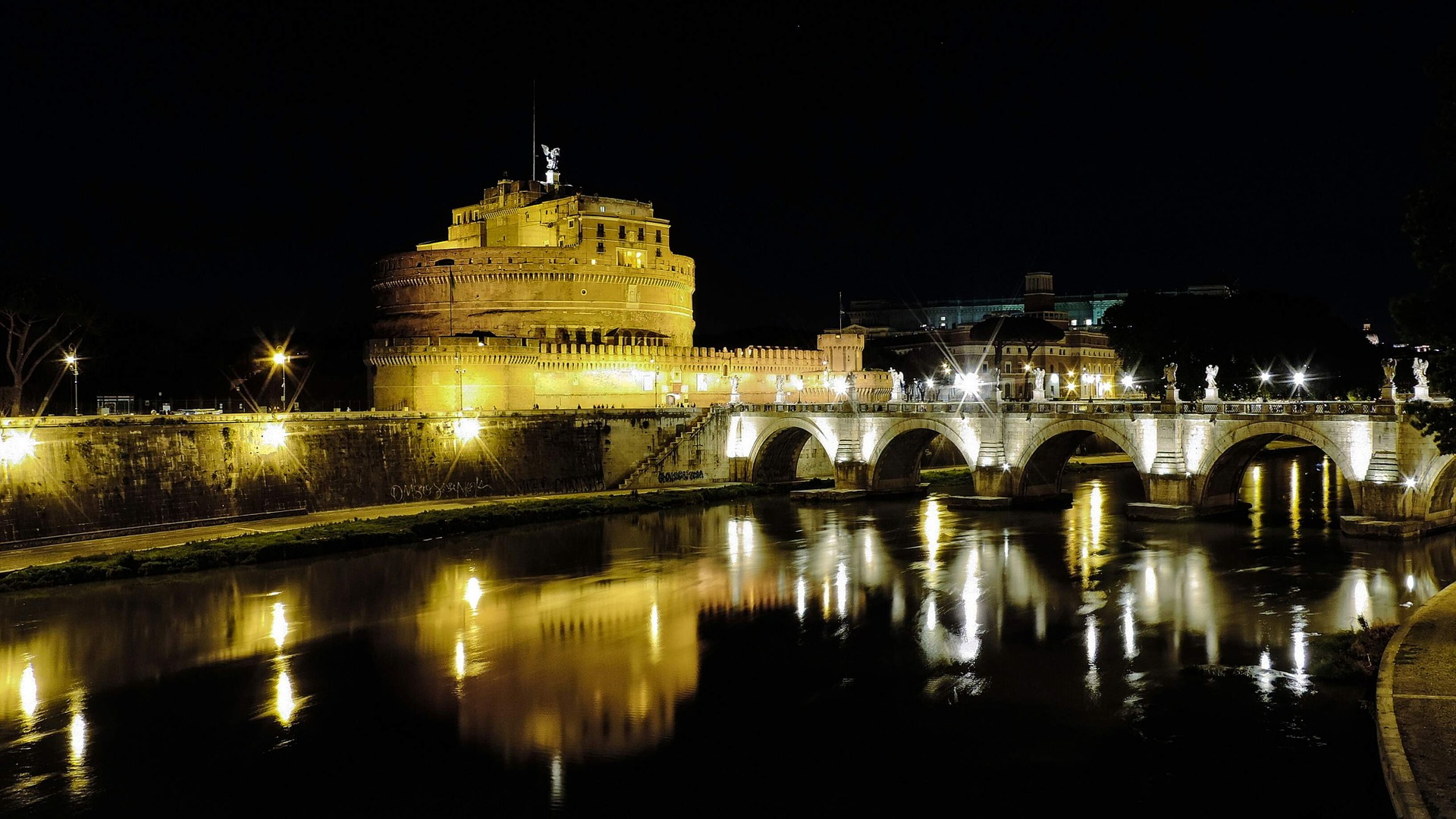
In a city like Rome, where history pervades every street and every stone, some of the historical figures who populated it alive, still do it in the form of a spirit or ghost. Legend, fantasy or reality, at night, these hidden presences, whose soul is trapped between the world of the living and that of the dead, wander in the places they inhabited.
The Pimpaccia on his fiery chariot overflowing with treasures that runs wild on Ponte Sisto, Messalina wandering on Colle Oppio, and then Beatrice Cenci, Cagliostro, and others.
We propose you an itinerary on the tracks of the restless souls and their mysteries that, at nightfall, come out into the open to infest the most famous streets and squares of the historic center of the Capital.
Messalina (25-48 BC)
Near the Colosseum, next to the remains of the Temple of Emperor Claudius, wanders one of the most famous ghosts of imperial antiquity: a woman wrapped in a white peplum, her arms covered in jewels and a diadem in her hair, looking for yet another lover. It is Messalina, the beautiful daughter of the consul Marco Valerio Messalla Barbato and Domizia Lepida. Barely fourteen, Caligula forced her to marry her mother's cousin, the future emperor Claudius, who was more than thirty years older than her, stutterer, lame, and at his third marriage.
It is said that the young woman, dissatisfied with her marriage, began to lead a disorderly existence made up of extramarital affairs and sexual adventures in the city brothels. Her escapades were also documented by authoritative chroniclers such as Suetonius, Tacitus, and Juvenal. In short, all of Rome was aware of Messalina's transgressive behavior, except Claudio. When the girl fell in love with the consul Gaius Silio, enough to simulate a marriage with him, the emperor decreed her death. Messalina's life ended at the age of 23.
Nero (37-68 AC)
Legend has it that after his death, the controversial Emperor Nero was buried in the center of Piazza del Popolo and that a walnut tree was planted above his tomb. His bones, however, began to attract spirits and demons that brought great fear to the residents of the area. The citizens asked Pope Pasquale II for help. In 1099, he had an apparition of the Vergin Mary, who suggested that he cut down the walnut, unearth the bones of the Emperor, burn, and disperse them in the Tiber.
The spirits disappeared, and a chapel dedicated to the Virgin Mary was built in place of the walnut.
In 1472, Pope Sixtus IV built the current Basilica of Santa Maria del Popolo. Inside it, above the main altar, there is an arch decorated with bas-reliefs depicting Pope Pasquale II in the act of cutting down the walnut tree.
Beatrice Cenci (1577-99)
The most famous ghost in Rome is, perhaps, that of Beatrice Cenci, a young Roman noblewoman of the late Renaissance period. Her tragic story inspired painters, including Guido Reni, poets, and novelists such as Shelley and Stendhal.
Forced to live with a father-master, Beatrice decided to report him after years of violence. Her requests for help, however, fell on deaf ears, although anyone in Rome knew what kind of person Francesco Cenci was. At the height of exasperation, Beatrice, Lucrezia, her father's second wife, her brothers Giacomo and Bernardo, the castellan Olimpio Calvetti, and the farrier Marzio da Fioran, decided to kill him. Giacomo stunned him with opium mixed with a drink. Once asleep, Marzio broke his legs with a rolling pin, and Olimpio finished him by hitting him on the skull and throat with a nail and a hammer. To simulate an accidental death, they decided to throw Francesco’s body off a balustrade.
But the wounds deemed incompatible with a simple fall. By investigating further, even with the use of torture, the investigators obtained full confessions from the suspects. The trial sentenced all of them to death, and their execution took place at dawn on 11 September 1599.
According to Beatrice's instructions, her body was buried in an anonymous tomb in the cemetery of San Pietro in Montorio.
Since then, every year on the night between 10 and 11 September, some swear to have seen the ghost of a young woman walking back and forth along the bridge leading to Castel Sant'Angelo, with her own cut-off head in the hands.
Donna Olimpia Maidalchini Pamphilj, the Pimpaccia (1592-1657)
In Piazza Navona, lived and thrived Donna Olimpia Maidalchini Pamphilj, better known as the Pimpaccia. Born from a family of modest conditions, she married Pamphilio Pamphilj, a Roman nobleman and Cardinal Giovanni Battista's brother, soon Pope Innocent X.
From the family palace, directly facing onto Piazza Navona, she reigned like a real queen, weaving political plots, manipulating events, and Innocent X himself. Her influence on him was known to all, and she quickly became the only person he trusted for every decision. Ambassadors, artists, merchants, and politicians knew that it was necessary to go through her to be introduced to the pope's court. For this, they literally covered her with gold and priceless gifts. Obsessed with money, power, and excess, she accumulated enormous wealth, regardless of the people who despised her and even accused her of being the pope's lover. Her "fortunes" ceased on 7 January 1655, the day Innocent X died.
A few hours before the pope's death, she filled two cases with gold coins, loaded them onto a carriage, and fled the city to never come back. Alexander VII, the pope who succeeded Innocent, exiled her to San Martino al Cimino, a small town north of Rome. He asked her to return the gold but received a resounding no. Donna Olimpia died of plague two years later.
Since then, every 7 January, her ghost can be spotted whizzing aboard a burning black carriage, between Piazza Navona and Ponte Sisto, heading to Trastevere. Eventually, the chariot loaded with gold and coins, and Donna Olimpia, disappear into the waters of the Tiber, where the devils fish her out and lead her to Hell.
Costanza Conti De Cupis (17th century)
Another famous ghost is that of the Roman noblewoman Costanza Conti De Cupis, whose presence haunts the family palace, overlooking Piazza Navona. A woman of undoubted charm and attractiveness, known in the city for the perfection of her hands, considered the most beautiful in Rome. The artist Bastiano reproduced them in a plaster cast to be kept in his workshop in Via dei Serpenti. Romans gathered there to admire it.
One day, a foreigner, or according to another version of the legend, a friar of San Pietro in Vincoli said that the woman to whom the hands belonged would soon lose them. When the voice of prophecy reached Constance, she was terrified by it. She asked for the cast to be destroyed, and from that day on, she never left her house, in the hope that the prediction would not come true. But while embroidering, she pricked her finger. The tiny wound first produced an infection and then gangrene that quickly spread from hand to arm that had to be amputated. But the septicemia had already invaded her debilitated body, and Costanza died a few days after.
It is said that since then when the moon illuminates the night and the windows of the ancient palace, the pale shape of Constance’s perfect hand appears from behind a window.
Cagliostro and Lorenza Feliciani (18th century)
Behind Piazza Farnese, in Vicolo delle Grotte, the ghost of Giuseppe Balsamo, better known as Alexander, Count of Cagliostro, ambitious esotericist, alchemist and freemason, but also healer, forger, and fraudster, wanders.
Cagliostro met the beautiful seventeen years old Lorenza Serafina Feliciani, his future wife, in a pleasure house located right in Vicolo delle Grotte. After their wedding, celebrated in 1768 in San Salvatore in Campo, Lorenza accompanies him on his frequent trips to Italy and Europe. Returning to Rome in 1789, she lodged a complaint against her husband, accusing him of a long series of crimes, including mistreatment, the exercise of magic, solicitation, fraud, and heresy. Cagliostro was arrested and locked up in Castel Sant’Angelo, where he even underwent 43 interrogations. At trial, Lorenza confirmed her accusations, and Cagliostro was sentenced to life imprisonment in a cell without doors, where he was dropped from a trap door on the ceiling, and where he died four years later.
It is said that, during the night, Cagliostro returns to Vicolo delle Grotte, desperately calling the name of his dissolute wife.
As for Lorenza Feliciani, she was acquitted of aiding and abetting charges but was confined for 15 years in the Convent of Santa Apollonia. From 1806 until she died in 1810, she was a concierge at the Germanic College in Piazza Sant’Apollinare and had to endure remorse for the accusations against Cagliostro. Popular folklore tells of a woman with her face veiled in black who always follows the same route between the alleys of Trastevere and Piazza di Spagna, the place where Cagliostro was arrested. It is the ghost of Lorenza, who, among whispers and moans, desperately wanders in search of her husband.
Mastro Titta, executioner in the papal Rome (1779-1869)
Just before sunrise, near Castel Sant'Angelo, it is easy to come across a strange character wrapped in a scarlet cloak. It is Giovanni Battista Bugatti, the legendary Mastro Titta, the most famous executioner in the papal Rome.
It is said that he loves to walk in the places where the sentences were executed. Public capital executions took place in Piazza del Popolo, Campo de 'Fiori, Ponte Sant'Angelo, or Piazza del Velabro. But the executioners couldn't dwell inside the city walls and had to find accommodation beyond the Tiber, between Castel Sant'Angelo and the Vatican. They could only cross the river and head to the city, the day of an execution.
Mastro Titta, who lived in the Borgo district on the right bank of the Tiber, had to cross Ponte Sant'Angelo to provide his services. This contributed to the birth of one of the most famous popular sayings: "Mastro Titta is crossing the bridge.". Someone, that same day, would be executed.
Between 1796 and 1864, he slew over 500 convicts, for an average of 7 executions per year.
His lethal practices included hanging, killing with a bat, beheading with the guillotine, and even the squaring, reserved for the perpetrators of particularly heinous crimes, whose severed body was exposed at the four corners of the gallows.
A curious tradition, which lasted until the day they ended in 1870, was born among the Romans who participated in the executions: fathers brought their male children to witness the torture and death of the condemned. At the exact moment when a head jumped, or someone was hanging on the noose and exhaling the last breath, the boy received a slap, as a warning.
It is said that sometimes Mastro Titta offered a pinch of snuff to the condemned to make him comfortable and suffering more bearable. So, if you meet a strange individual walking on Ponte Sant'Angelo offering you tobacco, run away because it is Mastro Titta, the executioner of Rome.
Other Ghosts
Among the places where the highest number of spirits appears, is the Muro Torto at Villa Borghese. Here, there was a cemetery where thieves, vagabonds, and women of easy virtue were buried. Their souls, stuck between the land of the living and the world of the dead, wander in search of revenge for having been forced to eternal damnation. Among these, Targhini and Montanari, two Carbonari beheaded in 1825, can be spotted under the walls at night, with their heads under their arms.
The ghosts of the two inseparable friends, John Keats and Percy Bysshe Shelley, the famous romantic poets, on the other hand, walk arm in arm talking amiably in Piazza di Spagna, where the unfortunate Keats, who died of tuberculosis at the age of twenty-five, resided.
Navona Square
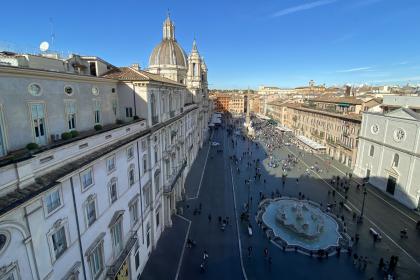
 Condividi
Condividi
The most iconic square of Baroque Rome
Sant'Angelo Castle
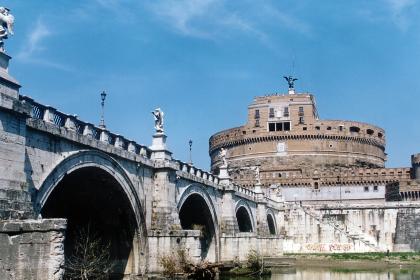
 Condividi
Condividi
Sant'Angelo bridge
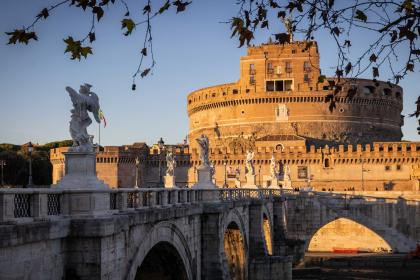
 Condividi
Condividi
Piazza del Popolo
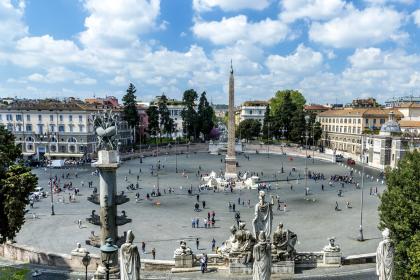
 Condividi
Condividi
The Basilica of Santa Maria del Popolo

 Condividi
Condividi
Villa Borghese

 Condividi
Condividi
Piazza di Spagna
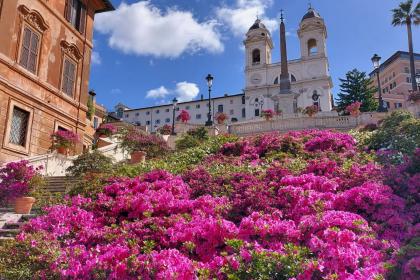
 Condividi
Condividi











































